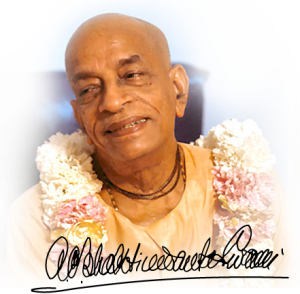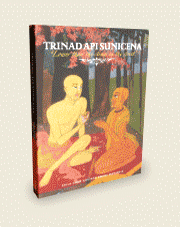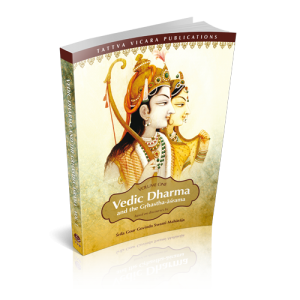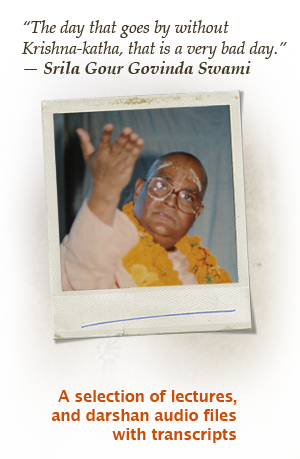[divider]
[typography font=”Homemade Apple” size=”22″ size_format=”px”]“One Who is Always Embraced by Krishna”[/typography]
Krsnalingita Vigraha — Volume One 1929-1978
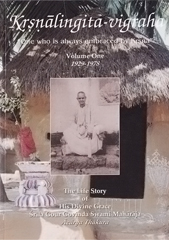
The Authorised Life Story In this detailed description of the life of His Divine Grace Srila Gour Govinda Swami, by his personal secretary of several years, the reader learns about the exulted nature of the pure devotee of the Lord; his life of devotion and prayer, and his search for the ultimate goal of life. Volume 1 of a 6-part series; 14.5 x 21 cm, Softbound, 328 pgs
READ CHAPTER 1 TO 3
[toggle title_open=”Chapter 1 – Gadei Giri, a Village of Devotees” title_closed=”Chapter One” hide=”yes” border=”yes” style=”white” excerpt_length=”0″ read_more_text=”Read More” read_less_text=”Read Less” include_excerpt_html=”no”]
naham tisthami vaikunthe
yoginam hrdayesu va
tatra tisthami narada
yatra gayanti mad-bhaktah
“My dear Narada, actually I do not reside in My abode, Vaikuntha, nor do I reside within the hearts of the yogis, but I reside in that place where My pure devotees chant My holy name and discuss My form, pastimes and qualities.”
This book places you in Orissa, one of the twenty-two states of India, some three hundred years ago, in a village called Gadai-Giri. As you may know, in India there are many holy places where the Lord has appeared personally and where His great devotees appeared. Gadai Giri is the one of those transcendental places where great devotees of the Lord take birth; it is no ordinary place, and the residents there are not ordinary personalities. Gadai Giri is a very famous village in the district of Cuttack, which is to be found on the eastern side of Orissa. It is approximately sixty-two kilometers from the town of Cuttack and ninety kilometers from Bhubaneswar, the state capital. The state of Orissa has a population of more or less thirty-two million people. It is materially impoverished when compared to some of the larger states of India, but is most wealthy spiritually, as it is the celebrated home of Lord Jagannatha—the Lord of the universe, who resides in a glorious temple at the heart of the holy city of Puri—Jagannatha Puri.
Jagannatha Puri, which is situated on the east coast of the sub-continent of India, is the place of pilgrimage for millions of pious Hindus; the huge temple of Jagannatha, which is said to be over two thousand years old, is there in all its splendor. The worship of Lord Krsna in His form of Lord Jagannatha has been going on there for many thousands of years predating the construction of the present temple. The residents of Orissa are most fortunate in this regard because they live in the land of Jagannatha, and the residents of Puri are even more fortunate as they are in the direct proximity of the Jagannatha temple, and this is the place where Mahaprabhu lived for eighteen years.
Sri Caitanya Mahaprabhu spent the last eighteen years of His manifest pastimes on earth in the land of Orissa, primarily at Puri. Sri Caitanya Mahaprabhu is the incarnation of Lord Krsna who appeared in West Bengal, India, in 1486 some 512 years ago to enact wonderful, dramatic pastimes of inculcating unto one and all the pure ecstatic chanting of the holy name of the Lord: Hare Krsna Hare Krsna Krsna Krsna Hare Hare, Hare Rama Hare Rama Rama Rama Hare Hare.
He was large in stature and had a golden bodily hue and He began the sankirtana movement which was predicted in the Vedas over 5,000 years ago. It was also predicted that this sankirtana movement would spread widely, especially to the western countries. Orissa and Bengal are said to be the two main states of India where the followers of Sri Caitanya Mahaprabhu appear and are known as oriyas and gaudiyas.
The Village of the Holy Name
The village of Gadai Giri, situated amidst the tranquil solitude of rural Orissa, surrounded by lotus-filled ponds and green paddy fields, has a most interesting history. A great devotee of Mahaprabhu named Gadai Giri, who hailed from Midnapore in Bengal, some three hundred years ago, came to Orissa to do business, dealing in brass cooking utensils. The local Zamindar (Squire-the principle local landowner) became very favorably disposed towards Gadai Giri by virtue of his good nature and good behavior, and he allowed him to stay in the locality. So Gadai Giri remained with his family in one village, and that village soon became known as the village of Gadai Giri.
Gopal Giri was the son of Gadai Giri. He was religiously minded and had learned kirtana from the devotees of Mahaprabhu’s home district of Nadia, Bengal. He was a great devotee of Lord Jagannatha. It was he who named the village after his father, the “Gadai Giri Village.”
The Giri dynasty has been very famous throughout the whole of Orissa from the time of Syamananda Pandita (Mid-sixteenth century) for their kirtana: (the chanting of the holy name of the Lord, Hare Krsna Hare Krsna Krsna Krsna Hare Hare, Hare Rama Hare Rama Rama Rama Hare Hare) and for their great devotion to the Lord. His Divine Grace Srila Gour Govinda Maharaja has said, “Syamananda Pandita used to preach in this area—Orissa. Jiva Gosvami had sent three people to preach—Syamananda Prabhu, Narottama Dasa Thakura and Srinivasa Acarya. Srinivasa Acarya remained in Bengal. Narottama Dasa Thakura went to Assam—Manipur, that side of India, and Syamananda Pandita came to Orissa. Jiva Gosvami had said, “Go out and preach.” This they did!”
This village of Gadai Giri has been flooded with the sound of kirtana since the time of Syamananda Pandita. Great devotees have taken birth in the Giri dynasty only to satisfy the desire of the Supreme Lord so that He may hear the sweet kirtana from the Gadai Giri kirtaniyas. This Gadai Giri kirtana cannot be learned like a dramatic or musical performance; it is born into the Giri family. It is in their blood, and this can be seen by their great devotion to the Lord and heard in their wondrous kirtana.
The Giri Family
The Giri family produced (and to this day still produces) on one side of the family, talented singers, who could sing very sweet kirtana (and when harmoniums were introduced into India by the British they accompanied their sweet singing with the harmonium) and on the other side, mrdanga players (drummers). Since the time of Sri Caitanya Mahaprabhu, all the villages of Orissa have had a kirtana party, but none are as famous as the kirtana party from Gadai Giri. Some three hundred years ago, which would place us around the year 1690, Gopal Giri and his family were worshipping a deity* of Lord Jagannatha. There was no deity of Lord Baladeva and no deity of Subhadra Devi, only a deity of Lord Jagannatha. Gopal Giri had constructed a small temple where the worship took place.
Gopal Giri in Puri
Gopal Giri was working in the town of Puri, in the Jagannatha Temple as the poddara (treasure/cashier) and was directly responsible to the king. Gopal Giri was very qualified to hold this position as he was a very well educated person, and completely trustworthy.
He was very well known and respected by everyone in Puri. His position was secure and his day-to-day life was calm and pleasant enough, apart from lingering thought in the back of his mind that he wanted to worship the deity of Lord Gopala. In Gopal Giri’s heart was a strong desire to worship the Lord in His eternal form of Lord Gopala. Even whilst dutifully carrying out his obligations as a treasurer, he was always praying for that time when he could give his occupation and fully dedicate his life to the service and pleasure of his ista-deva—Lord Gopala—Krsna the cowherd boy. He cried for the Lord to appear before him in that form and accept whatever service he could offer.
In the town of Puri, many sadhus (holy men) would come to see the Supreme Lord in the Jagannatha temple. When Gopal Giri sometimes met with these sadhus, he would ask; “Please give me your blessings so that I may obtain a deity of Lord Gopala; it is my heart’s desire to worship Him.” But most of them would reply, “If you want to worship Lord Gopala, then you will have to go to Vrndavana.** There you will find the Lord of your heart.” Now the dilemma for Gopala Giri was that he was serving in Puri and was unable to travel in Vrndavana, as the only means to get there in those days was by bullock cart or on foot and that would have taken many months, and he would not be allowed to take time off from his work.
Gopala and the Vaisnava Babaji
In Vrndavana there lived a vaisnava-babaji,*** who everyday would go door to door begging alms, doing madhukari. During the daytime he would go out and collect a little rice, a little dal, which in the evening he would cook and then offer it to his deity Sri Gopala Jiu, who normally resided in the babaji’s shoulder bag. He would first offer the cooked rice and dal to the Lord and then he would take the remnants as prasada. He would eat and afterwards place the deity back in the bag. In this way he was leading his life, wandering throughout the forests of Vrndavana.
The Babaji’s Dream
One night the deity of Gopala Jiu appeared to the babaji in a dream, and told him, “You take me to Gopal Giri, the son of Gadai Giri; he wants to worship Me. Take Me to Jagannatha Puri where Gopal Giri is working! I want to hear the kirtana performed by the residents of Gadai Giri.” But the babaji did not pay very much attention to it -“After all”, he considered, “It was only a dream!” He did not take it very seriously and carried on his daily routine as usual, as if nothing had happened. However, some days later the deity appeared to the babaji again in dream, this time with cane in hand; He beat the babaji severely. When the babaji awoke he could see that he had wounds all over his body where Gopala had beaten him very severely. He at once realized his mistake and begged the Lord’s forgiveness for committing such a great offence. He had not followed the command of the Lord, even though Gopala Jiu had been kind enough to personally appear before him and gave him instruction whilst he was dreaming. The babaji then said; “O, my Lord, You have beaten me very severely; with so many wounds on my body, how can I possibly go to Puri now? Unless my wounds are healed, how can I go there?” The deity of Gopala Jiu then said to the babaji; “No! You take me to Puri and hand me over to Gopal Giri. Once this is done, ask Gopal Giri to place his hand on your hand on your body. When he does this all of your wounds will disappear immediately; otherwise your wounds will never heal. So please do not delay, let us leave at once! I will give you the directions as to how to go to Puri and where Gopal Giri lives.”
* Deity: The symbol representation of the transcendental form of the Lord in stone, wood, metal, paint, or within one’s mind; The deity form of the Lord is transcendental because in the spiritual world, a symbol is identical with the thing it represents. (The self-realized soul confirms these symbolic forms of the Lord, because he has seen the Lord, face to face.) In the revealed scriptures, it is described that the Lord can be understood in three ways. The first is the impersonal form, Brahman. (This is also understood by some effulgence of God or the bright light.) The second is the Lord in the heart, the supersoul or the Paramatma. The third understanding, and the highest, is the direct vision of the Lord, the Supreme Personality of Godhead, Sri Krsna. This is all evidenced by the self-realized souls.
The Journey from Vrndavana to Puri
Immediately the babaji set out for Puri from Vrndavana. In those days travel was mainly by foot, so the journey from Vrndavana to Jagannatha Puri took two and a half months; the distance traveled was two thousand two hundred kilometers. There was also no facility for the babaji to send a message in advance to inform the residents of Puri that Lord Gopala Jiu was coming to satisfy the desire of Gopal Giri. He did not even know who Gopal Giri was or what he looked like. He just set out for Puri town with faith in the order of the Supreme Lord. The babaji was the servant of the deity and the deity said that He wanted to go to Puri, and that was that!
Upon his arrival in Puri the babaji enquired as to the whereabouts of Gopal Giri and soon discovered that he was at that time staying in a rented house in the area known as Kundheibenta Sahi. The local town people directed him to Gopal Giri’s house, which was to be found three to four kilometers from the temple of Jagannatha in the direction of the Gundica Mandir on the north side of Puri. As it was quite late in the evening, the babaji decided to stay that night near the Jagannatha temple and to visit Gopal Giri early the next morning.
The Babaji Meets Gopal Giri
As it so happened, Gopal Giri had just finished bathing and was putting on his tilaka when he heard a knock at the door. He went to see who it was and saw a babaji standing at the entrance to his house. Babaji Maharaja inquired if he was indeed Gopal Giri, “I have brought with me the deity of Sri Gopala Jiu who has come all the way from Vrndavana so that you may worship Him.” He took the Lord from his bag. Gopal Giri was astonished to say the least as he gazed in wonder at this most beautiful form of his merciful Lord. He then asked the babaji who he was and where he had come from. The babaji related the whole story to Gopal Giri and asked him to touch his body so that his wounds would heal. The babaji gave the deity of Gopala Jiu to Gopal Giri who then touched the babaji’s body and as the Lord had promised him, all his wounds were immediately!
Gopal Giri was amazed that his desire had come true; The Lord had come all the way from Vrndavana just so that he could worship Him. In a great bliss he went to the market to purchase the finest quality rice, dal and vegetables and upon returning home gave them to the babaji so he could cook for Lord Gopala. His next course of action was to approach the King and offer his resignation. The King however, was not present in his palace at that time, so he submitted his resignation in written to the King’s officers. He then went home and saw that the offering was made by the babaji to the Lord. After the Lord was satisfied, Gopal Giri and the babaji took the prasada, the remnants of Lord Gopala Jiu’s meal.
Sometime after, Gopal Giri opened his cash box and asked the vaisnava-babaji to take as much money as he wanted. But the babaji said, “No! I will not take any money! I am the servant of Gopala. Wherever Lord Gopala will go I will go also and serve Him! I am not a person to sell the deity, I am His servant! I will not take any money; wherever Gopala will go, I will go there and serve Him!”
Gopal Giri Resigns from Government Service
Sometime later, Gopal Giri was summoned to see the King. The King asked him, “Why have you resigned? Please explain your actions?” Gopal Giri explained to the King his desire to worship Gopala Jiu, and how the deity had come from Vrndavana, being brought by a vaisnava-babaji. He also explained to the King that in his village he had built a temple and now he wanted to install Lord Gopala and begin His worship very nicely. They would have kirtana everyday for the Lord. On hearing this the King was very pleased and said, “All right, as today your desire to worship Lord Gopala has been fulfilled, I have no objection. But I do have one single request of you—that sometimes you must come to Puri with the kirtana party from Gadai Giri and perform kirtana in the temple for the pleasure of Lord Jagannatha.” Gopal Giri of course accepted the conditions of the king who then released him from all his other duties at the Jagannatha temple.
Gopal Giri Returns to Gadai Giri with Lord Gopala Jiu
Gopal Giri returned to his village with Lord Gopala, and the vaisnava-babaji accompanied them so that he could help with the worship of Gopala Jiu. Sri Gopala Jiu was installed in the temple especially constructed for Him, along with a beautiful deity of His eternal consort, Srimati Radharani whose golden form was fashioned from brass by a local sthapati (deity sculptor). And so, the Divine Couple Sri Sri Radha-Gopala Jiu stood on the altar in the temple at Gadai Giri. The Giri family were not poor by any means. In fact they were very wealthy; they had many acres of land surrounding the temple. They were also the most famous kirtaniyas in the land of Orissa, with a special invitation from the King of Puri to chant in the Puri temple for Lord Jagannatha whenever they could. (That invitation still holds to this day and is written in the history book of the temple of Lord Jagannatha—the madala-panji). The Supreme Lord in His deity form had come all the way from Vrndavana to hear the kirtana at Gadai Giri. So daily kirtana was performed at the temple, very sweet kirtana for the pleasure of Sri Sri Radha-Gopal Jiu. The main business of the Giri family was deity worship and hari-kirtana. Lord Gopala Himself was very happy to hear the kirtana. As it is described in the sastra:
naham tisthami vaikunthe
yoginam hrdayesu va
tatra tisthami narada
yatra gayanti mad-bhaktah
“My dear Narada, actually I do not reside in My abode, Vaikuntha, nor do I reside within the hearts of the yogis, but I reside in that place where My pure devotees chant My holy name and discuss My form, pastimes and qualities.”
When relating this story of Sri Sri Radha-Gopala Jiu, His Divine Grace Srila Gour Govinda Maharaja said, “The Supreme Lord is very happy to hear His own glorification,” and quoted the above verse.Gopal Giri arranged all the land and other properties for the service of Gopala Jiu. Sometime later the babaji left his body in Gadai Giri, fully engaged in the service of Gopala Jiu. Gopal Giri also engaged many other Vaisnava in the daily worship. Gopal Giri remained on this for eighty-five years completely absorbed in the service of the Divine Couple, his most beloved Sri Sri Radha-Gopal Jiu.
The Son Who Could Not Sing
Just one kilometer from Gadai Giri village there is a temple of the Goddess Thakurani, The Goddess Durga. This temple is in the village of Nagapur. As has already been described, the Giri family were, and still are, famous throughout Orissa for their kirtana; they are kirtana-gurus. Once, in this dynasty of Giri, there was an innocent but ignorant member of the family called Abhiram Giri. He could neither play mrdanga nor sing sweet kirtana, much to the disgust of his father, who was himself most famous for his kirtana. Once after performing kirtana, the local villagers were enquiring from the father, Dinabandhu Giri, “Why doesn’t your son ever lead kirtana for the Lord’s pleasure?” The father, being rather embarrassed, replied, “This son of mine is ignorant in this regard, he cannot sing nor play the mrdanga.” The villagers were amazed and said, “What is this—amazing! Such a famous person! All in your line are all famous kirtaniyas. Why is your son ignorant in this regard?” Abhiram Giri was present there, and on hearing this discussion he was greatly ashamed, and left that place with a troubled mind. He headed straight for the temple of the Goddess Thakurani where he prostrated himself on the floor of the temple and didn’t move for three days. He took neither water nor food, he just lay there. Within his heart he was crying for the benediction to become a very good kirtana leader, or otherwise it would be better for him if he just gave up his body. After three days of lying prostrated on the temple room floor, and taking no food or water, he received merciful benedictions of the Goddess Thakurani. From that very day he became famous as the leader of the most wondrous kirtanas. Such are the glories of the ‘family of kirtana’. The Gadai Giri kirtaniyas.
The Deity of Sri Gopala Jiu is Stolen
Once, some 150 years ago, there was a devotee who was helping with the worship of Gopala Jiu. He was apparently a babaji, a renounced monk, but actually he was a thief in the guise of a babaji. He would often help the brahmana in doing the worship, making garlands, dressing the deities and performing aratis (arati: is a traditional Vedic ceremony during which offerings of incense, ghee lamps, flowers, water etc. are made to the deity of the Lord). One night this ‘babaji’ decided that he would have the deity for himself and so he stole Lord Gopala Jiu, while the brahmana who was in charge of the worship was fast asleep. The babaji-thief headed in the direction of a nearby village called Bishi Muhana, which is approximately three kilometers from Gadai Giri temple. In a dream that very night the deity spoke to Bhagat Charan Giri, who was at that time the village leader. “I have been stolen by this ‘babaji’ and I am lying here near the village of Bishi Muhana. The ‘babaji’ is now dead snake bite so please come and get Me.” Bhagat Charan Giri immediately woke up and came to the temple to find that deity was indeed missing. By this time the brahmana had also awoken and was yelling at the top of his voice, “The deity has gone, the deity has been stolen!” Bhagat Charan Giri told him of his dream in which the deity had appeared to him. Also in that dream Bhagat Charan Giri had seen torch burning in the direction of the village Bishi Muhana. He quickly organized a very large kirtana party, formed with many of the villagers from Gadai Giri. It was an enormous procession with mrdanga, karatalas and many villagers holding flaming torches. They headed in the direction of the mystical burning torch that they could see off in the distance; the same one that Bhagat Giri had seen in his dream. When Bhagat Giri and his kirtana party finally reached the spot where the flaming torch should have been (it disappeared as they approached) they found the body of the babaji-thief who had been bitten by a snake, and the deity of Sri Gopala Jiu. A mighty kirtana was performed, and taking Lord Sri Gopala Jiu with them they returned to their village. Upon arrival back at Gadai Giri the brahmana performed a fire sacrifice and replaced the deity of the Lord on His temple altar.
[hr]
**Vrndavana: It is the transcendental place where Krsna enjoys His eternal pastimes as a young cowherd boy, and it is considered the topmost sphere in all existence. When this Vrndavana is exhibited in the material world it is known as Gokula, and in the spiritual world it is called Goloka, or Goloka Vrndavana.
***Babaji: A renounced monk, a babaji chants Hare Krsna all day long, and spends the minimum amount of time on the bodily needs, such as eating and sleeping.
[/toggle]
[toggle title_open=”Chapter 2 – The Custodians of Sri Sri Radha-Gopal Jiu Temple” title_closed=”Chapter Two” hide=”yes” border=”yes” style=”white” include_excerpt_html=”no”]
- Gadai Giri came from West Bengal.
- Gadai Giri had a son named Gopal Giri who is famous for initiating the worship of Sri Sri Radha-Gopala Jiu.
- Dinabandhu Giri was the son of Gopal Giri and he remained on this earth for seventy-five years in the service of Gopala Jiu.
- The son of Dinabandhu Giri was Abhiram Giri. He gave up his body aged ninety years after spending most of his time in the service of Gopala Jiu.
- Abhiram Giri’s son was Bhagat Charan Giri. He lived for eighty-two years and for most of his life he did regular seva to Gopala Jiu. He became a kirtana-guru in this locality and was greatly honored by the local Zamindar, from whom he received a certificate to the effect that he was, such a great kirtana leader.
- Bhagat Charan Giri had two sons-Laksman Giri and Bhikari Giri. Bhikari Giri became a sannyasi at the age of thirty years and spent the rest of his life in Vrndavana. Prior to his taking sannyasa he was a grhastha and had a son named Govinda Giri. Govinda Giri was six years old when his father took sannyasa. Govinda Giri was very, very expert in kirtana. Throughout his eighty-eight years he served Gopala Jiu regularly with great devotion.
- The next in line as a custodian for the Gopala Jiu Mandir was Bauribandhu Giri, who was the son of Govinda Giri. Bauribandhu Giri had three sons; Gopinath Giri, Jagannath Giri and Dinabandhu Giri. He also had one daughter named Pata Dei Giri, the mother of His Divine Grace Sri Srimad Gour Govinda Swami Maharaja—Brajabandhu Manik.
- Bauribandhu Giri handed the custodianship of the temple to his son Gopinath Giri. Gopinath Giri handed the seva of Gopala Jiu over to his son Ghanasyam Giri.
- Ghanasyam Giri then passed the seva of Gopala Jiu, including the land on which the Gopala temple is situated, to His Divine Grace Srila Gour Govinda Swami Maharaja, who was his cousin, in November 1993. His Divine Grace has since established there a very wonderful temple for his most beloved Sri Sri Radha-Gopala Jiu.
This is the village of Gadai Giri. It is most famous; the kirtana party from Gadai Giri is most famous and the deity coming from Vrndavana—Gopala Jiu—is most famous. It is into this great Vaisnava dynasty that His Divine Grace Srila Gour Govinda Swami Maharaja was born. The following chapters will reveal the most wonderful life and pastimes of His Divine Grace Srila Gour Govinda Swami Maharaja (Brajabandhu Manik). Throughout his entire life, from his very childhood, the deities of Sri Sri Radha-Gopala Jiu were constantly the object of his love, devotion and meditation. In the diary that His Divine Grace Srila Gour Govinda Swami Maharaja kept every day without fail, he would start each entry, “By Gopala’s mercy…”
[/toggle]
[toggle title_open=”Chapter 3 – The Holy Appearance of His Divine Grace Srila Gour Govinda Swami Maharaja” title_closed=”Chapter Three” hide=”yes” border=”yes” style=”white” excerpt_length=”0″ read_more_text=”Read More” read_less_text=”Read Less” include_excerpt_html=”no”]
“Brajabandhu Manik”
“…I can remember, from when I was very young, my grandfather and father and all my uncles, they had sikha, tilaka and wore kanthi-mala, they were all Vaisnavas and they were always chanting Hare Krsna.” — His Divine Grace Srila Gour Govinda Swami Maharaja
The Appearance of a Vaisnava
The birth of Vaisnava is unlike the birth of a conditioned soul; he takes his birth under the auspices of the Supreme Lord; he is not forced by the illusory energy (maya) to appear in this material world:
na karma-bandhanam janma vaisnavanam ca vidyate
visnur anucaratvam hi moksam ahur manisinah
“A Vaisnava does not take birth under the jurisdiction of karmic law. His birth and disappearance are transcendental. The wise have declared that the servants of Visnu are eternally engaged in the liberated service of the Lord and hence are free from the laws of material nature.”
ataeva vaisnavera janma mrtyu nai
sange aisena, sange yayena tathai
dharma, karma, janma vaisnavera kabhu nahe
padma-puranete iha vyakta kari’ kahe
“The Padma Purana has said; Vaisnavas do not undergo birth and death like ordinary persons. They appear and disappear within this world of their own accord. In this way sometimes we have their association and sometimes their association is withdrawn. The devotees are not subject to any worldly considerations of duty and karma.”
The Divine Appearance
His Divine Grace Srila Gour Govinda Swami Maharaja made his appearance in the village of Jagannathpur, in the district of Cuttack, in the state Orissa, India. Jagannathpur is approximately eighty-five kilometers from Bhubaneswar, the state capital, fifty-five kilometers from the city of Cuttack and fifteen kilometers from Gadai Giri. He was born on the second of September 1929 at 7:30 am*. This day fell one week after Janmastami (The holy appearance day of Lord Krsna) and one week prior to Radhastami (The holy appearance day of the Lord’s eternal consort Srimati Radharani). Having performed auspicious ceremonies (samskaras) according to the Vedic tradition, his begot their first son, whom they named Brajabandhu. At the time of his divine appearance the karatalas rang and the mrdangas beat a thunderous sound as they combined in kirtana to joyfully celebrate the birth in the family of kirtaniyas from Gadai Giri. Gadai Giri village was replete with the sound of the holy name and in Jagannathpur the infant Brajabandhu was nestled up against his mother sound asleep.
His father was Isvara Manik (dasa) and his mother was Pata Dei Giri. Both were born in families who had a long-standing Vaisnava tradition. His mother’s family were the residents of the famous Gadai Giri village, the descendants of the famous Gopal Giri.
Brajabandhu’s father’s family were also Vaisnavas. The whole family was initiated into the Vaisnava system. Those who take Vaisnava initiation vow to stop all eating of flesh, to stop gambling, to stop all intoxication and to refrain from illicit sex. Initiated Vaisnavas also vow to chant a prescribed number of rounds (japa)** each day.
At this time India was still under British rule. Yet pressure was mounting against the British to give India complete independence. These events had little effect on the Giri or the Manik families.
Also, at this time the powerful mission of Srila Bhaktisiddhanta Sarasvati Gosvami Prabhupada, the Gaudiya Math, was mighty force to be reckoned with. Under the guidance of Srila Bhaktisiddhanta Sarasvati Gosvami Prabhupada, this mission was preaching vigorously against the many atheistic mentalities that were prevalent in India at that time, especially the idea that anyone and everyone is God.
Srila Bhaktisiddhanta Sarasvati Gosvami Prabhupada preached powerfully against caste-ism and the sahajiyas, and was very effective at defeating and discrediting these very strongly rooted these very strongly rooted influences in Indian cultural and religious tradition. This was practically one of his most important contributions, coupled with his constant axe blows against the impersonalists and voidists.
He also did much to establish a unifying influence on the various Vaisnava sects by stressing the points of agreement shared by the four major sampradays. He published the writings of the other Vaisnava acaryas, especially Srila Madhvacarya and Srila Ramanujacarya and also published accounts of their lives.
In his travels throughout India and especially South India, he enjoyed a reputation as an incredibly powerful debator, and received the title “simha-guru”—the lion guru. Various proponents of the Mayavadi School would cross the street rather than confront him, and he was known to accost such scholars and chastise them for cheating the innocent public with false philosophy.
*This day is also the same day and month that His Divine Grace Srila Bhaktivinoda Thakura took his birth in this world some 90 years earlier, one astrologer was also noted as saying that His Divine Grace Gour Govinda Swami in his last birth was Srila Bhaktivinoda Thakura.
** Japa: The chanting of the Hare Krsna maha-mantra on a string of sacred tulasi-wood beads.
Srila Bhaktisiddhanta Sarasvati Gosvami Prabhupada had established sixty-four mathas (temples) within India, initiated sixty thousand disciples and had established four printing presses in order to print and distribute his own works and the works of the previous acaryas.
Despite the political upheaval modern India was going through, life in Gadai Giri and Jagannathpur was relatively peaceful and quite. They were not so interested in the fight for supremacy in Indian politics, whether it were the British or Indian Nationalists; service to Krsna was far greater than any mundane political system. They were too busy serving Krsna and doing Krsna-bhajana. And this beautiful child—a son—was born in their family, much to the delight of all the Giris and the Maniks.
In the Bhagavad-gita Lord Krsna has said: man-mana bhava mad-bhakto, mad-yaji mam namaskuru—“Always think of Me, become My devotee, worship Me, and offer obeisances to Me.” This they did and this was their sole interest in life!
Vedic Dharma
It was and still is prevalent in India (Bharata-varsa)*** that children are born at home. His Divine Grace Gour Govinda Maharaja said, “I was born at home, not in the hospital, and so were six out of my seven children. This is the Vedic process.”
The Vedic system is that the children are born at home and stay with the mother for a period of up to thirty days. After they leave the house and enter the temple for the first time. Prior to this time the mother and the child do not leave the house. This is one of the many religious observances carried out by the mother and the child called samskaras, for the purification of the mother and the child. Brajabandhu and his mother followed this observance and his first journey from home was to see the beautiful form of the Lord in the local temple.
The main reason that the mother and child do not leave the house for a certain period of time is that during that time, the mother is considered unclean (asuci). Also at that time the mother and child undergo many types of ayurvedic and naturopathic treatments, so the custom in India is to keep the mother and child inside the room for the twenty-one days that they are not considered as suci (clean). After twenty-one days the mother can bathe nicely. Within that twenty-one day period, if she bathes she may become ill. Therefore generally the ayurvedic doctors do not advise bathing during this twenty-one day period. So since she has not bathed, she is not considered clean and therefore she remains inside.
Vaisnava Association From Birth
Daily his father would rise early, bathe, put on tilaka and chant Hare Krsna. His father also wore kanthi-mala which is a main feature of Vaisnava attire. Isvara Manik was a very simple-hearted person and very serious about his devotional practices. He was seen by the local people as a Vaisnava, a follower of the followers of the Mahaprabhu.
From his birth Brajabandhu was surrounded by Vaisnavas—devotees with sikha, tilaka, wearing kanthi-mala and chanting the Holy name of the Lord.**** His father chanted Hare Krsna, his uncles chanted Hare Krsna, his grandfather chanted Hare Krsna and his mother chanted Hare Krsna.
Srila Gour Govinda Swami Maharaja: I can remember, from when I was very young, my grandfather and father and all my uncles, they had sikha, tilaka and wore kanthi-mala, they were all Vaisnavas and they were always chanting Hare Krsna. After bathing they would put on Vaisnava tilaka, they were all Vaisnavas.
At home his life revolved around the service of the Supreme Lord, with both his parents and all of their relatives constantly engaged in service to the family deities.
As devotees, the Manik family and the Giri family had great faith in the words of Lord Krsna in Bhagavad-gita and the Srimad-Bhagavatam, the ancient Vedic scriptures of India. Every evening the Giri family would read one chapter of the Srimad-Bhagavatam after holding kirtana at the Sri Sri Radha-Gopala Jiu temple. Reading from the sacred scriptures was included as part of their puja, or their daily worship. In such ideal Vaisnava circumstances Brajabandhu took his birth.
*** Bharat-varsa: The scriptural name for India (the land of Bharata). Named after Bharata, son of Dusyanta and Sakuntala.
**** The sikha is the short tuft of hair that devotees have at the back of their head; tilaka are the markings found on the forehead and the body of a devotee. Wearing a tilaka spiritualizes the body and makes it a temple of the Lord. Kanthi-mala are the three strands of beads that devotees have around their neck. The wearing of these three items signifies that a person is a follower of Krsna His incarnation for this age, Sri Caitanya Mahaprabhu.
[/toggle]
